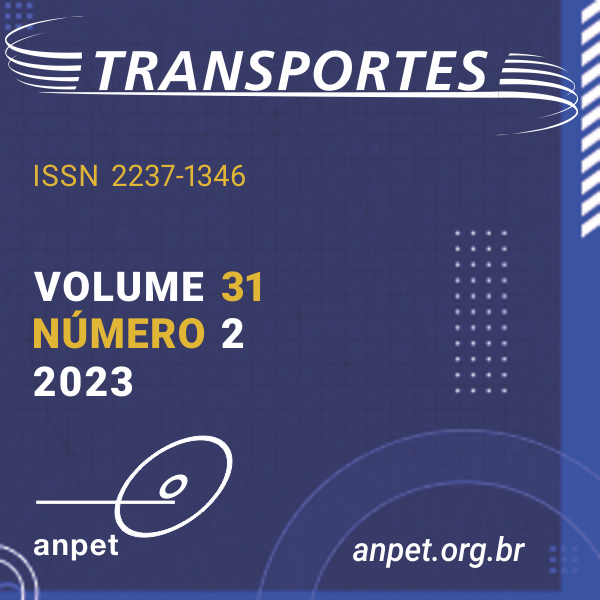Development of friction coefficient prediction models for Brazilian runways using Artificial Neural Networks
DOI:
https://doi.org/10.58922/transportes.v31i2.2792Keywords:
Airfield pavements, Skid resistance, Coefficient of friction, Operational safetyAbstract
Landing and takeoff procedures are the prior most critical phases of a flight, once they are up to several factors that play a fundamental role in its performance, these include the pilot´s skill, weather states and skid resistance. In this context, the friction coefficient represents an important parameter for operational safety in terms of tirepavement adherence. In that fashion, this research aims to offer confident prediction models supported by Artificial Neural Networks as a way of quantifying friction coefficient based on 3-6 meters from the axis of runways (RWY) through different types of equipment in virtue of assisting the aerodrome operator with respect of safety procedural requirements, in addition to verifying the influence of grooving upon friction coefficient performance. The models developed have achieved some satisfactory results, given the complexity of the problem, emphasizing the significance of further improvements, even though these models might settle on ways that help guide and control RWY safety procedures
Downloads
References
Abiodun, O.I.; A. Jantan; A.E. Omolara et al. (2018) State-of-the-art in artificial neural network applications: a survey. Heliyon, v. 4, n. 11, p. E00938. DOI: 10.1016/j.heliyon.2018.e00938. DOI: https://doi.org/10.1016/j.heliyon.2018.e00938
ANAC (2019) RBAC 153: Aeródromos - Operação, Manutenção e Resposta à Emergência. Emenda nº 4. Brasília: Agência Nacional de Aviação Civil.
ANAC (2021) Consulta Interativa – Indicadores do Mercado de Transporte Aéreo. Brasília: Agência Nacional de Aviação Civi.
Anupam, K.; S.K. Srirangam; A. Scarpas et al. (2013) Influence of temperature on tire-pavement friction analyses. Transportation Research Record, v. 2369, n. 1, p. 114-124. DOI: 10.3141/2369-13. DOI: https://doi.org/10.3141/2369-13
Aps, M. (2006) Classificação da Aderência Pneu-Pavimento Pelo Índice Combinado IFI – International Friction Index para Revestimentos Asfálticos. Thesis (Ph.D.). Escola Politécnica, Universidade de São Paulo, São Paulo, SP. DOI: 10.11606/T.3.2006.tde-11122006-144825 DOI: https://doi.org/10.11606/T.3.2006.tde-11122006-144825
Bocanegra, C.W.R. (2002) Procedimentos para Tornar Mais Efetivo o Uso das Redes Neurais Artificiais em Planejamento de Transportes. Dissertation (master of science). Escola de Engenharia de São Carlos, Universidade de São Paulo, São Carlos, SP. DOI: 10.11606/D.18.2002.tde-06032002-131951. DOI: https://doi.org/10.11606/D.18.2002.tde-06032002-131951
Bosurgi, G. and F. Trifirò (2005) A model based on artificial neural networks and genetic algorithms for pavement maintenance management. International Journal of Pavement Engineering, v. 6, n. 3, p. 201-209. DOI: 10.1080/10298430500195432. DOI: https://doi.org/10.1080/10298430500195432
Chelliah, T.; P. Stephanos; T. Smith et al. (2002) Developing a design policy to improve pavement surface characteristics. In Transportation Research Board (ed.) Pavement Evaluation Conference. Location: Transportation Research Board, p. 1-19.
Chen, J.S.; C.C. Huang; C.H. Chen et al. (2008) Effect of rubber deposits on runway pavement friction characteristics. Transportation Research Record, v. 2068, n. 1, p. 119-125. DOI: 10.3141/2068-13. DOI: https://doi.org/10.3141/2068-13
Costa, S.L.; V.T.F. Castelo Branco and E.F. Freitas (2017) Avaliação da aderência pneu-pavimento para diferentes tipos de pavimentos utilizando o International Friction Index (IFI). In Associação Nacional de Pesquisa e Ensino em Transporte (org.) XXXI Congresso da Associação Nacional de Pesquisa e Ensino em Transporte. Recife: ANPET, p. 1-12.
Domitrovic, J.; T. Rukavina and H. Dragovan (2018) Application of an artificial neural network in pavement management system. Technical Gazette, v. 25, p. 466-473. DOI: 10.17559/TV-20150608121810. DOI: https://doi.org/10.17559/TV-20150608121810
Flintsch, G.W.; J.P. Zaniewski and J. Delton (1996) Artificial neural network for selecting pavement rehabilitation projects. Transportation Research Record, v. 1524, n. 1, p. 185-193. DOI: 10.1177/0361198196152400122. DOI: https://doi.org/10.1177/0361198196152400122
Flintsch, G.W.; Y. Luo and I.L. Al-Qadi (2005) Analysis of the effect of pavement temperature on the frictional properties of flexible pavement surfaces. In Transportation Research Board (org.) 84th Transportation Research Board Annual Meeting. Washington, D.C.: Transportation Research Board.
Fonseca, O.A. (1990) Manutenção de Pavimentos de Aeroportos. Brasília: Diretoria de Engenharia da Aeronáutica/Divisão de Estudos e Projetos de Infraestrutura/Ministério da Aeronáutica.
Fwa, T.F.; W.T. Chan and C.T. Lim (1997) Decision framework for pavement friction management of airport runways. Journal of Transportation Engineering, v. 123, n. 6, p. 429-435. DOI: 10.1061/(ASCE)0733-947X(1997)123:6(429). DOI: https://doi.org/10.1061/(ASCE)0733-947X(1997)123:6(429)
Géron, A. (2017) Hands-on Machine Learning with Scikit-learn & TensorFlow. Sebastopol: O’Reilly.
Haykin, S. (2009) Neural Networks and Learning Machines (3rd ed.). Upper Saddle River, NJ: Pearson.
Hossain, M.I.; L.S.P. Gopisetti and M.S. Miah (2019) International roughness index prediction of flexible pavements using neural networks. Journal of Transportation Engineering, Part B: Pavements, v. 145, n. 1, p. 04018058. DOI: 10.1061/JPEODX.0000088. DOI: https://doi.org/10.1061/JPEODX.0000088
ICAO (2019) State of Global Aviation Safety: Safety Report. Montreal: International Civil Aviation Organization.
Kazda, A. and R.E. Caves (2007) Airport Design and Operation (2nd ed). New York: Elsevier Science.
Masad, E.; A. Rezaei; A. Chowdhury et al. (2009) Predicting Asphalt Mixture Skid Resistance Based on Aggregate Characteristics. Austin: Texas Transportation Institute. Available at: <https://static.tti.tamu.edu/tti.tamu.edu/documents/0-5627-1.pdf > (accessed 03/17/2023).
McDaniel, R.S.; K.J. Kowalski; A. Shah et al. (2010) Long Term Performance of a Porous Friction Course. West Lafayette: Taylor & Francis Online. DOI: https://doi.org/10.5703/1288284314284
Najafi, S.; G.W. Flintsch and S. Khaleghian (2019) Pavement friction management – artificial neural network approach. International Journal of Pavement Engineering, v. 20, n. 2, p. 125-135. DOI: 10.1080/10298436.2016.1264221. DOI: https://doi.org/10.1080/10298436.2016.1264221
Oliveira, P.V.S. (2017) Estudo Preliminar do Comportamento da Capacidade de Atrito nas Pistas de Pouso e Decolagem do Aeroporto Pinto Martins. Undergraduate thesis (bachelor degree). Universidade Federal do Ceará, Fortaleza, CE. Available at: <http://www.repositorio.ufc.br/handle/riufc/29491> (accessed 03/17/2023).
Quariguasi, J.B.F.; F.H.L. Oliveira and S.D.S. Reis (2021) A prediction model of the coefficient of friction for runway using artificial neural networks. Transportes, v. 29, n. 2, p. 2401. DOI: 10.14295/transportes.v29i2.2401. DOI: https://doi.org/10.14295/transportes.v29i2.2401
Ribeiro, A.J.A.; C.A.U. Silva and S.H.D.A. Barroso (2018) Metodologia de baixo custo para mapeamento geoté cnico aplicado à pavimentação. Transportes, v. 26, n. 2, p. 84-100. DOI: 10.14295/transportes.v26i2.1491. DOI: https://doi.org/10.14295/transportes.v26i2.1491
Santos, A.; E. Freitas; S. Faria et al. (2014) Degradation prediction model for friction in highways. In Murgante, B.; S. Misra; A.M.A.C. Rocha et al. (eds.) Computational Science and Its Applications - ICCSA 2014 14th International Conference, Guimarães, Portugal, June 30 - July 3, 204, Proceedings, Part III. Cham: Springer, p. 606-614. DOI: 10.1007/978-3-319-09150-1_44. DOI: https://doi.org/10.1007/978-3-319-09150-1_44
Shahin, M.Y. (2005) Pavement Management for Airports, Roads, and Parking Lots (2nd ed). New York: Springer
Skerritt, W.H. (1993) Aggregate type and traffic volume as controlling factors in bituminous pavement friction. Transportation Research Record, v. 1418, p. 22-29.
Susanna, A.; M. Crispino; F. Giustozzi et al. (2017) Deterioration trends of asphalt pavement friction and roughness from medium-term surveys on major Italian roads. International Journal of Pavement Research and Technology, v. 10, n. 5, p. 421-433. DOI: 10.1016/j.ijprt.2017.07.002. DOI: https://doi.org/10.1016/j.ijprt.2017.07.002
Thube, D.T. (2012) Artificial Neural Network (ANN) based pavement deterioration models for low volume roads in India. International Journal of Pavement Research and Technology, v. 5, n. 2, p. 115-120.
Yao, L.; Q. Dong; J. Jiang et al. (2019) Establishment of prediction models of asphalt pavement performance based on a novel data calibration method and neural network. Transportation Research Record, v. 2673, n. 1, p. 66-82. DOI: 10.1177/0361198118822501. DOI: https://doi.org/10.1177/0361198118822501
Downloads
Published
How to Cite
Issue
Section
License
Copyright (c) 2023 Túlio Rodrigues Ribeiro, Francisco Heber Lacerda de Oliveira

This work is licensed under a Creative Commons Attribution 4.0 International License.
Authors who submit papers for publication by TRANSPORTES agree to the following terms:
- The authors retain the copyright and grant Transportes the right of first publication of the manuscript, without any financial charge, and waive any other remuneration for its publication by ANPET.
- Upon publication by Transportes, the manuscript is automatically licensed under the Creative Commons License CC BY 4.0 license. This license permits the work to be shared with proper attribution to the authors and its original publication in this journal, and to be adapted for non-commercial purposes, provided appropriate credit is given and any derivative works are distributed under the same terms.
- Authors are authorized to enter into additional separate contracts for the non-exclusive distribution of the version of the manuscript published in this journal (e.g., publishing in an institutional repository or as a book chapter), with recognition of the initial publication in this journal, provided that such a contract does not imply an endorsement of the content of the manuscript or the new medium by ANPET.
- Authors are permitted and encouraged to publish and distribute their work online (e.g., in institutional repositories or on their personal websites) after the editorial process is complete. As Transportes provides open access to all published issues, authors are encouraged to use links to the DOI of their article in these cases.
- Authors guarantee that they have obtained the necessary authorization from their employers for the transfer of rights under this agreement, if these employers hold any copyright over the manuscript. Additionally, authors assume all responsibility for any copyright infringements by these employers, releasing ANPET and Transportes from any responsibility in this regard.
- Authors assume full responsibility for the content of the manuscript, including the necessary and appropriate authorizations for the disclosure of collected data and obtained results, releasing ANPET and Transportes from any responsibility in this regard.









